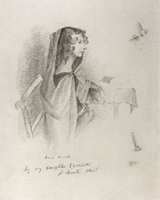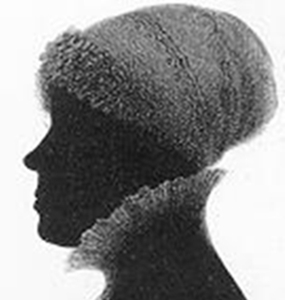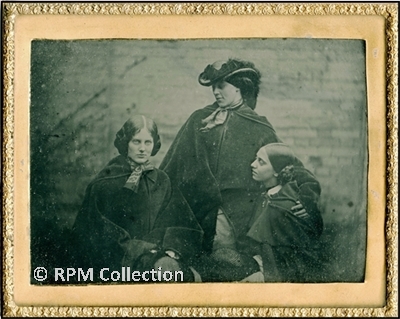| |
Emily Bronte
|
| Comparing
Emily |
|
Portraits of Anne, and variations of them, have been used as illustrations
of Emily from 1897 to the present day (see Anne-esque
Portraits). The 'Profile portrait' (NPG 1724) and the associated tracing are identified as Emily
Bronte but almost certainly depict her sister Anne (see Profile Portrait - Emily or Anne) as she
had a Roman nose. This means that the left-hand tracing from the
'Gun-Group' portrait, depicting a young woman with a straight nose, will be Emily. The
only undisputed portrait of Emily Bronte is that seen in the 'Pillar Portrait.'
|
|
Portraits of
Emily
|
|

|
|
LEFT: Assumed to be Emily Bronte c1834 in a tracing from the
'Gun Group' portrait.
CENTRE: Undisputed portrait of Emily Bronte c1833 in the 'Pillar Portrait,'
painted by her teenage brother, Branwell; she would be about 15 years old.
RIGHT: 'Emily' in the Photograph; if this is Emily Bronte and the photo was
taken c1848 she would be about 30 years old.
|
|
Missing Portraits of
Emily
|
|
It has long been a mystery as to why Charlotte's portraits of Anne have survived
but none of Emily.
|
Missing
Pencil Portrait.
|
|

The Pencil sketch of Anne Bronte by
Charlotte.
|
Martha Brown owned
two pencil sketches
by Charlotte, one of Anne and one of Emily. These were
seen by William Robertson Nicoll when he
visited her in 1879.
"Martha
Brown possessed a very clearly and boldly drawn pencil sketch of Emily by
Charlotte, which I in vain endeavoured to purchase."
After Martha's death in January 1880 he purchased the sketch of
Anne from one of her sisters but could not trace the one of
Emily.
|
|
Missing Watercolour Portrait?
|
|
This portrait of Anne appears on p.230 of Art of the
Brontes, it is a miniature oval watercolour, by Charlotte. Does one exist of
Emily?

The miniature oval watercolour of
Anne Bronte by Charlotte.
|
|
There is one unidentified watercolour portrait by
Charlotte, the portrait seen below of an unknown woman. It is a miniature
oval watercolour created in the same period as the one of her sister
Anne. Detail of the image is shown here, reversed for comparison with the
photo.

Note the earring.
The full portrait can be found on p.231 of Art of the
Brontes where it is suggested that she could be the Bronte Sisters' Aunt
Elizabeth Branwell. 1.
|

|
 |
|
Aunt Elizabeth
Branwell (1776-1842).
|
|
|
|
Descriptions of
Emily.
|
|
Descriptions of Emily by people who actually knew or met
her are few but physical and mental strength is a recurring
theme.
|
|
“Stronger than a man, simpler than a child, her nature stood
alone."
Charlotte Bronte.3.
|
|
"She should have been a man—a great navigator..... She had a
head for logic, and a capability of argument unusual in a man and rarer indeed in a
woman...impairing this gift was her stubborn tenacity of will which rendered her
obtuse to all reasoning where her own wishes, or her own sense of right, was
concerned."
Constantin Héger.
|
|
"We always thought her to be the best looking, the
cleverest, and the bravest-spirited of the three sisters.”
Martha Brown quoted in Mary
Robinson's Emily Bronte.
|
|

|
|
"I simply disliked her from the first, her tallish, ungainly, ill-dressed
figure contrasting so strangely with Charlotte's small, neat, trim person, although
their dresses were alike."
Laetitia Wheelwright, pupil at the Pensionnat
Heger, quoted in 1896.
|
|
"Emily was the tallest. She'd bigger bones and was stronger
looking and more masculine, but very nice in her ways."
‘Old Haworth Folk Who Knew The
Brontes’ The Cornhill Magazine, New Series, vol. xxix. July to December 1910
London, Smith, Elder, & Co.
|
|
"Patrick 'had such unbounded confidence in his daughter
Emily, knowing, as he did her unparalleled intrepidity and firmness, that he
resolved to learn her to shoot too. They used to practice with pistols."
John Greenwood. 3a.
|
|
"she is a brave and noble girl. She is my right hand, nay, the very apple of
my eye!”
John Greenwood quoting Patrick Bronte. 3a.
|
|
|
George Henry
Lewes
|
|

Probably the most important clue as to Emily's appearance can be found in a
letter by Charlotte concerning the art critic, George Henry Lewes (1817-1878) whose "face
almost moves me to tears—it is so wonderfully like Emily—her eyes, her
features - the very nose, the somewhat
prominent mouth, the forehead-even at moments the expression."
Charlotte met George Henry Lewes in 1850 when he was 33 years old. The 'Emily'
in the photo is here compared with Lewes as a 23-year-old in 1840 and three undated photos
c1865-78.

|
|
The Branwell Family of
Penzance, Cornwall.
|
|
'Emily' in the photo bears no resemblance to Emily's father Patrick Bronte but
does have features associated with her mother's side of the family.

Emily's grandmother and mother Maria whose
family were the Branwell's from Penzance.
Photographs exist of Maria's first-cousins who lived in Penzance in the 1880s.
This branch of the family lived at Penlee House, Penzance, now a museum for West Cornwall. The
museum website has portraits and photographs of the Branwell family and a prominent chin and jaw
are recurring features.

Photos of Edith and Marion Branwell.
More photos from the Penlee House Museum
Website
|
|
The Carne Family
of Penzance, Cornwall.
|
|

Elizabeth Carne (1817-1873) of Penzance, Cornwall was a second cousin of the
Bronte sisters on the maternal side of the family. She was a geologist, author and
philanthropist. Her first publication came in 1860: 'Three Months' Rest at Pau in the
Winter and Spring of 1859’ under the pseudonym of John Altrayd
Wittitterly.4. Her father was the geologist Joseph Carne (1782-1858). Joseph's brother, John Carne (1789-1844) was also an author and travel writer.
|
|
Emily's Health in the
1840s
|
|
Reading the small amount of surviving evidence, Emily appears to have been in
good health throughout the 1840s, until 1848. In 1841 she wrote that "We are all stout and
hearty" and she was fit enough to make the long journey to Brussels with Charlotte in February
1842. She was well during most of their nine months in Belgium. They returned to England
in November 1842, and in a letter to Ellen Nussey in May 1843, all at the Parsonage were "in
good health" and "so was Anne according to the last accounts."
Again, in July 1845, "all are well at home" and she had spent two days
with Anne, visiting York and Keighley. They must have been fitter than many of us today as
they walked back the four miles, much of it uphill, from Keighley to Haworth. She sounds to be
mentally and physically active, happy and quite optimistic:
"I am quite contented for myself – not as idle as formerly, altogether
as hearty and having learnt to make the most of the present and hope for the future with less
fidgetiness that I cannot do all I wish – seldom or ever troubled with nothing to do, and
merely desiring that every body could be as comfortable as myself and as undesponding and then
we should have a very tolerable world of it...I must hurry off now to my taming and ironing I
have plenty of work on hands and writing and am altogether full of business."
When Emily fell ill in 1848, Charlotte wrote to Dr Epps stating that Emily had
“hitherto enjoyed pretty good health.” She continues... "she has never looked
strong" which could be taken as meaning that she was frail, but there's enough evidence to
show that she wasn't. This may be a reference to Emily's pale complexion, described by
various people as “sallow” or “pallid.”
Martha Brown stated that the sisters "were all well when Mr. Branwell was
buried; but Miss Emily broke down the next week."

Emily is thought to have had prominent upper teeth; this image shows detail from
the photograph.5.
|
|
|
|

The only undisputed portrait of Emily Bronte is rarely separated from the
'Pillar' portrait group and used as an illustration but a slightly
modified version did appear on the cover of Edward Chitham's A Life of Emily Bronte published in 2010.
|
|
|
Footnotes.
1. Alexander and Sellars, The Art of the Brontës,
p.231.
2. "Emily Brontë [aged about 15 years-old]
had by this time acquired a lithesome, graceful figure. She was the tallest person in the house,
except her father. Her hair, which was naturally as beautiful as Charlotte's, was in the same
unbecoming tight curl and frizz, and there was the same want of complexion. She had very beautiful
eyes – kind, kindling, liquid eyes; but she did not often look at you; she was too reserved. Their
colour might be said to be dark grey, at other times dark blue, they varied so. She talked very
little. She and Anne were like twins – inseparable companions, and in the very closest sympathy,
which never had any interruption. Anne—dear, gentle Anne—was quite different in appearance
from the others." Reminiscences of Charlotte Brontë. Ellen Nussey.
Scribner's Monthly, an illustrated magazine for the people Volume 2 Issue 1 (May 1871) Click here for the ebook (external website).
"She should have been a man—a great navigator. Her powerful reason would
have deduced new spheres of discovery from the knowledge of the old; and her strong imperious will
would never have been daunted by opposition or difficulty, never have given way but with life. She
had a head for logic, and a capability of argument unusual in a man and rarer indeed in a
woman...impairing this gift was her stubborn tenacity of will which rendered her obtuse to all
reasoning where her own wishes, or her own sense of right, was concerned." Constantin
Héger, 1842, referring to Emily Brontë, as quoted in The Oxford History of the Novel in English
(2011), Volume 3, p. 208
3. Biographical notice of Ellis and Acton Bell.
Charlotte Brontë, 1850.
3a. In 'Letters, Diary and Documents of John
Greenwood Belonging to Mrs Mary Preston, Haworth, Yorkshire,' quoted in Man of Sorrow: Life,
Letters and Times of the Reverend Patrick Bronte, 1777-1861, p.
369-370.
Patrick 'had
such unbounded confidence in his daughter Emily, knowing, as he did her unparalleled
intrepidity and firmness, that he resolved to learn her to shoot too.
They used to practice with
pistols. Let her be ever so busy in her domestic duties, whether in the kitchen baking
bread, at which she had such [a] dainty hand, or at her ironing, or at her studies, wrapt
in a world of her own creating - it mattered not; if he called upon her to take a lesson,
she would put all down.
His tender and
affectionate "Now, my dear girl, let me see how well you can
shoot today," was irresistible to her filial
nature, and her most winning and musical voice would be heard to sing through the house in
response "Yes, papa!" and away she would run with
such a hearty goodwill, taking the board from him and tripping like a fairy down to the bottom
of the garden, putting it in its proper position, then returning to her dear, revered parent,
take the pistol, which he had previously primed and loaded for her. "Now, my girl," he would
say, "take time, be steady". "Yes, papa", she
would say, taking the weapon with as firm hand and as steady an eye as any veteran of the camp
and fire.
Then she would
run to fetch the board for him to see how she had succeeded. And she did get so proficient,
that she was rarely far from the mark. His 'how cleverly you
have done, my dear girl!" was all she cared for. She knew she had gratified him and
she would return the pistol, saying, "Load again,
papa!" and away she would go into the kitchen, roll another shelf-full of teacakes,
then, wiping her hands, she would return again to the garden and call out,
"I'm ready again, papa," and so they would
go on until he thought she had had enough practice for that day.
"Oh! " he would exclaim, "she is a brave and noble girl. She is my right
hand, nay, the very apple of my eye!””
4. John Stewart lived in
Pau, France and visited Haworth Parsonage in 1856 and 1857. He knew Charlotte's publisher,
George Smith but there is no known connection with Elizabeth Carne.
5. "Emily was wont to sit bolt upright in the
corner of the pew, as motionless as a statue. Her compressed mouth and drooping eyelids and indeed
her whole demeanour appeared to indicate strong innate power. A large protruding tooth added to her
peculiar aspect."
Extract from a newspaper article "
Bradford Observer 17 April 1894 published in "Strange world of the Brontës" page
34.
"Questioned as to whether she could recall Emily Bronte, she
remembered her only in this light; she could not think of her individually but associated her with
Anne, the two sisters, she declared, being always together. One of them, she could not say which,
had very prominent "front teeth." I suggested this would
probably be Anne judging by the protrusion of the upper lip in Anne's portrait, but she could not
confirm my supposition. She added that she remembered Emily and Anne as being distinctly taller
than Charlotte, which, of course, is no new
information."
Evening Transcript 9 June 1915; Interview
with Mrs Wadsworth, aged 80 years, one of Charlotte Bronte's Sunday School
scholars.
|
|
|

